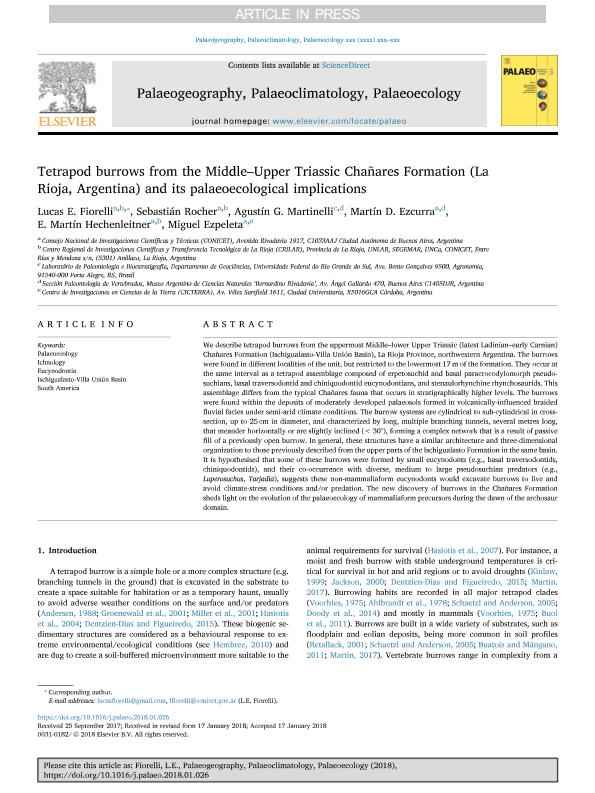Artículo
Tetrapod burrows from the Middle–Upper Triassic Chañares Formation (La Rioja, Argentina) and its palaeoecological implications
Fiorelli, Lucas Ernesto ; Rocher, Sebastian
; Rocher, Sebastian ; Martinelli, Agustín Guillermo
; Martinelli, Agustín Guillermo ; Ezcurra, Martin Daniel
; Ezcurra, Martin Daniel ; Hechenleitner, Esteban Martín
; Hechenleitner, Esteban Martín ; Ezpeleta, Miguel
; Ezpeleta, Miguel
 ; Rocher, Sebastian
; Rocher, Sebastian ; Martinelli, Agustín Guillermo
; Martinelli, Agustín Guillermo ; Ezcurra, Martin Daniel
; Ezcurra, Martin Daniel ; Hechenleitner, Esteban Martín
; Hechenleitner, Esteban Martín ; Ezpeleta, Miguel
; Ezpeleta, Miguel
Fecha de publicación:
05/2018
Editorial:
Elsevier Science
Revista:
Palaeogeography, Palaeoclimatology, Palaeoecology
ISSN:
0031-0182
Idioma:
Inglés
Tipo de recurso:
Artículo publicado
Clasificación temática:
Resumen
We describe tetrapod burrows from the uppermost Middle–lower Upper Triassic (latest Ladinian–early Carnian) Chañares Formation (Ischigualasto-Villa Unión Basin), La Rioja Province, northwestern Argentina. The burrows were found in different localities of the unit, but restricted to the lowermost 17 m of the formation. They occur at the same interval as a tetrapod assemblage composed of erpetosuchid and basal paracrocodylomorph pseudosuchians, basal traversodontid and chiniquodontid eucynodontians, and stenaulorhynchine rhynchosaurids. This assemblage differs from the typical Chañares fauna that occurs in stratigraphically higher levels. The burrows were found within the deposits of moderately developed palaeosols formed in volcanically-influenced braided fluvial facies under semi-arid climate conditions. The burrow systems are cylindrical to sub-cylindrical in cross-section, up to 25 cm in diameter, and characterized by long, multiple branching tunnels, several metres long, that meander horizontally or are slightly inclined (<30°), forming a complex network that is a result of passive fill of a previously open burrow. In general, these structures have a similar architecture and three-dimensional organization to those previously described from the upper parts of the Ischigualasto Formation in the same basin. It is hypothesised that some of these burrows were formed by small eucynodonts (e.g., basal traversodontids, chiniquodontids), and their co-occurrence with diverse, medium to large pseudosuchian predators (e.g., Luperosuchus, Tarjadia), suggests these non-mammaliaform eucynodonts would excavate burrows to live and avoid climate-stress conditions and/or predation. The new discovery of burrows in the Chañares Formation sheds light on the evolution of the palaeoecology of mammaliaform precursors during the dawn of the archosaur domain.
Archivos asociados
Licencia
Identificadores
Colecciones
Articulos(CRILAR)
Articulos de CENTRO REGIONAL DE INV. CIENTIFICAS Y TRANSFERENCIA TECNOLOGICA DE ANILLACO
Articulos de CENTRO REGIONAL DE INV. CIENTIFICAS Y TRANSFERENCIA TECNOLOGICA DE ANILLACO
Articulos(MACNBR)
Articulos de MUSEO ARG.DE CS.NAT "BERNARDINO RIVADAVIA"
Articulos de MUSEO ARG.DE CS.NAT "BERNARDINO RIVADAVIA"
Citación
Fiorelli, Lucas Ernesto; Rocher, Sebastian; Martinelli, Agustín Guillermo; Ezcurra, Martin Daniel; Hechenleitner, Esteban Martín; et al.; Tetrapod burrows from the Middle–Upper Triassic Chañares Formation (La Rioja, Argentina) and its palaeoecological implications; Elsevier Science; Palaeogeography, Palaeoclimatology, Palaeoecology; 496; 5-2018; 85-102
Compartir
Altmétricas



